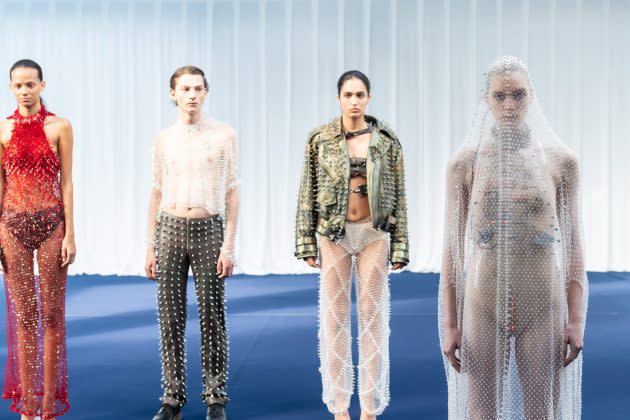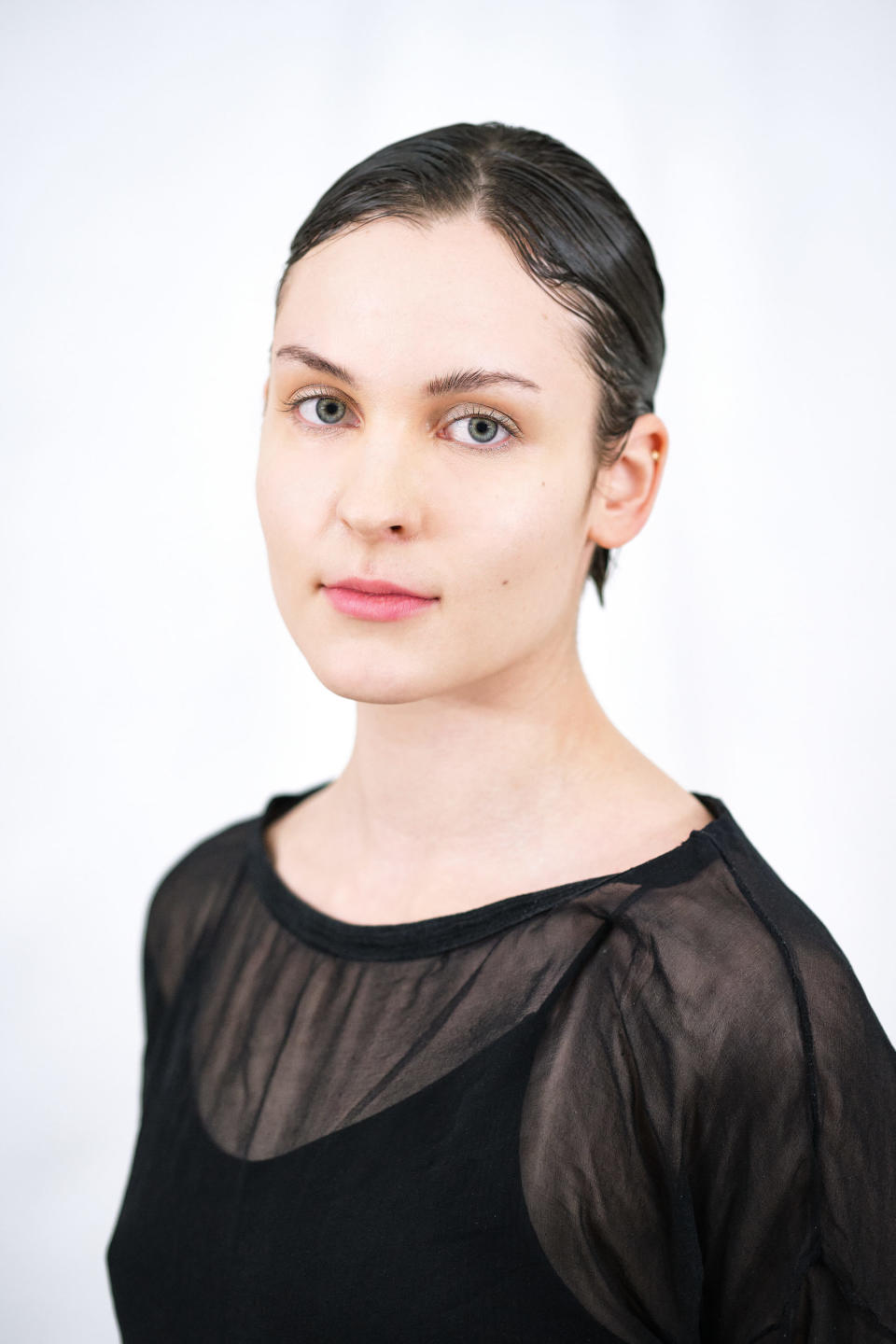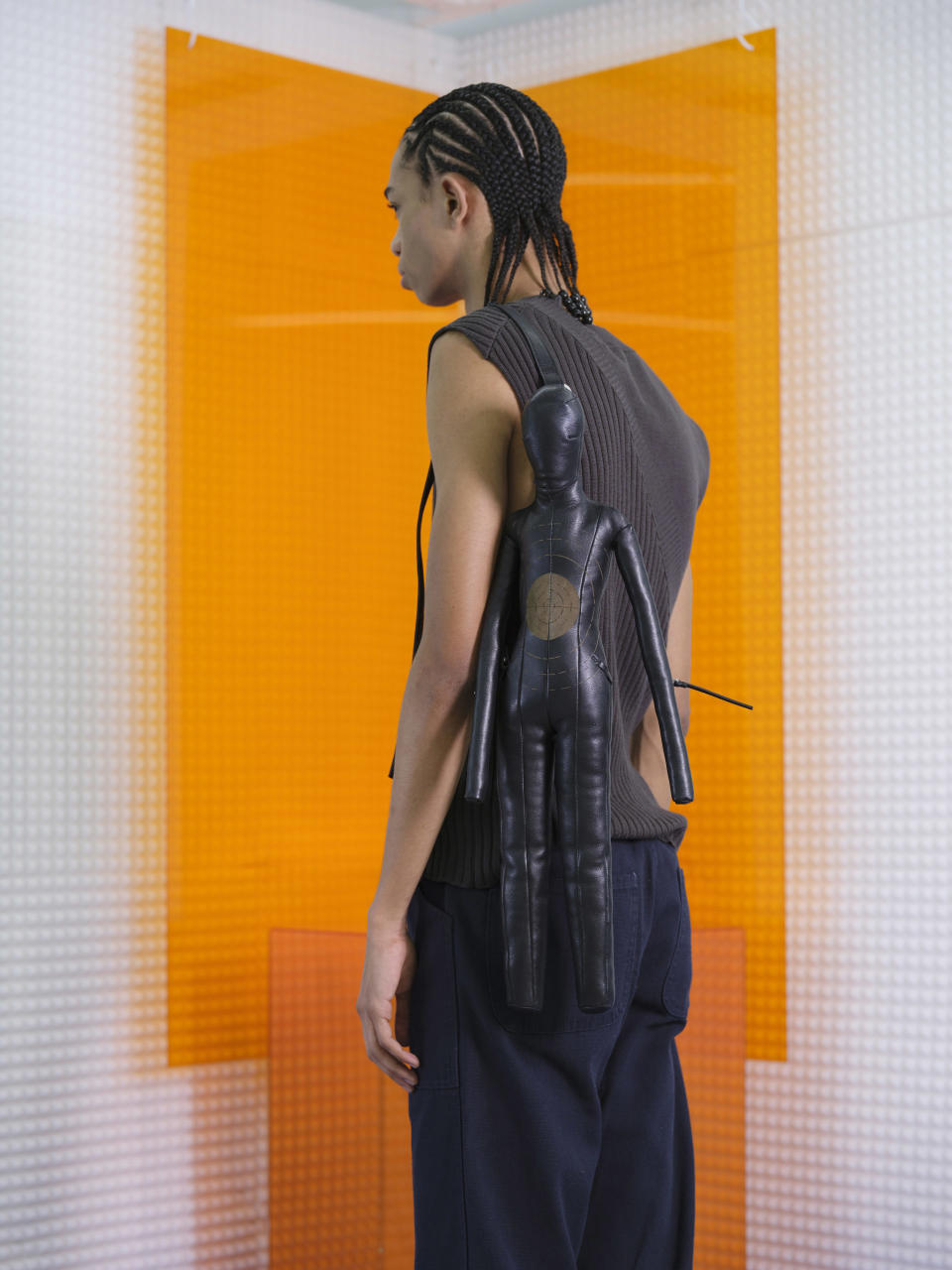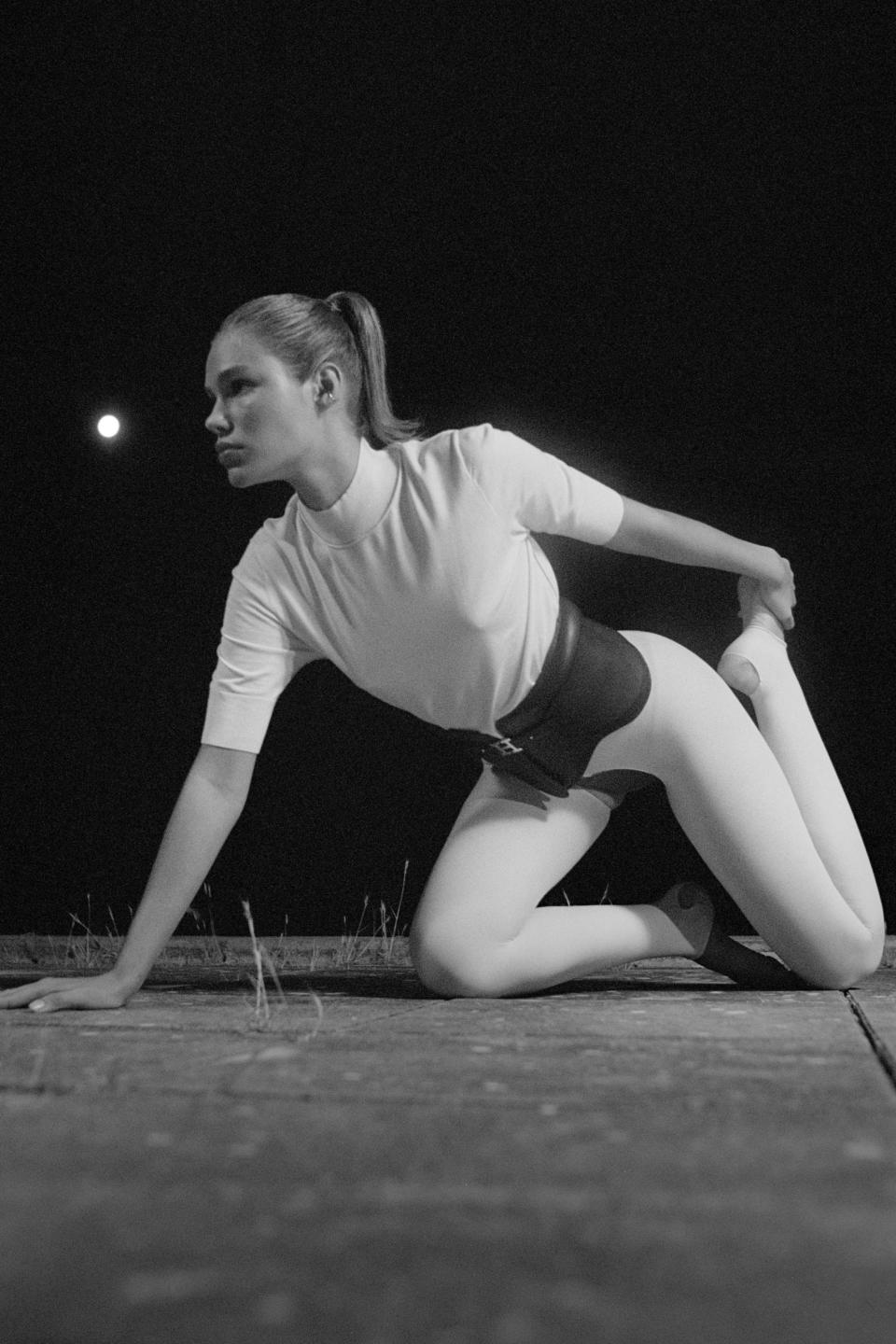Finnish Designer Jenny Hytönen Wins Top Fashion Prize at Hyères Festival

HYÈRES, France — Finnish designer Jenny Hytönen won the top prize at the 37th edition of the Hyères International Festival of Fashion, Photography and Fashion Accessories on Sunday, presenting a spiny, spiky knit collection to a jury headed by Y/Project and Diesel creative director Glenn Martens.
The Paris-based designer, currently interning at Olivier Theyskens’ label with a focus on knitwear, graduated from Aalto University School of Arts, Design and Architecture in 2021 with an award.
More from WWD
Her untitled unisex collection was topped by the “Cyborg,” which featured a bridal veil incorporating 25,000 glass beads hand placed during the knitting process, and an LED bodysuit with a heart sensor that materialized the wearer’s heartbeat with pulsating lights.
Another standout was a headdress, created with the support of Chanel-owned milliner Maison Michel, that resembled the titular character from the “Hellraiser” horror film franchise.
The lineup also won her the public’s vote after shows where she introduced herself as “loving knitwear and BDSM,” drawing laughter and applause.
Hytönen emerged as the winner after a hotly debated contest by the jury that included Ottolinger designers Christa Bösch and Cosima Gadient; stylist Ursina Gysi; artist Frederik Heyman; Mytheresa vice president of womenswear and kidswear fashion buying Tiffany Hsu; editors Mark Holgate and Eugénie Trochu; musicians Max Colombie and Sevdaliza, and last year’s Grand Prize winner Ifeanyi Okwuadi.

Martens lauded the quality of the 25-year-old Hytönen’s collection with a “very complete collection plan that nonetheless showed extreme creativity.”
Soft-spoken Hytönen felt the experience had already helped her grow from “being the shyest girl you’d ever meet.”
“My idea was always that I would work for myself but I didn’t expect it to happen so soon,” she said, noting that she wanted, for example, to find ways to combine her craftsmanship and more commercial products. For now, she’s in no rush as “patience is [her] superpower” — stringing 25,000 beads certainly attested to that.
In coming months Hytönen will be applying her learnings from Hyères by working on two commercially available capsule collections that will be commercialized in the second half of 2023, one with Galeries Lafayette and the other with incoming partner Icicle.
Overall Martens was impressed by a generation that “regardless of the aesthetics, or the story, or the background, [had] all embedded straight into the fundamental part of their work, social and environmental sustainability.”
“They’re really talking about the future of society, about loving each other, respecting each other, being free, doing whatever you want, as long as you respect each other,” on top of bringing “their own personal answer” to address “fashion [as] one of the topmost polluting industries,” he explained.
He hoped they would take from him the idea that “you just have to believe in yourself and go for it.” In his eyes, it’s important to understand that “the moment you start asking yourself too many questions based on [comments] by other people,” creatives get in trouble.
The Le19M Métiers d’Arts Prize in partnership with Chanel went to German designer Valentin Lessner, who was also singled out for the Mercedes-Benz Sustainability Prize for best applying the sustainable practices given by Fashion Open Studio, a nonprofit organization campaigning for a more sustainable luxury industry.
Jury member Hsu noted that craftsmanship was a recurring theme among the 2022 crop of contestants.
She felt that the pandemic and its isolation caused by lockdowns and restricted travels globally had pushed many to “start exploring within what’s available to them,” going back to “something quite primitive but also quite accessible” by learning crafts either online or from older family members.
While that was the situational component to the trend, Hsu also connected it to a ’90s trend of positivity and crafts-oriented personal expression.
Sini Saavala, also from Finland, scooped up the inaugural L’Atelier des Matières Prize, which comes with 10,000 euros worth of fabrics and leathers from L’Atelier des Matières, a structure created in 2019 on Chanel’s initiative and which collects unsold goods and unused materials to turn them back into usable resources.
The accessories grand prize went to Joshua Cannone and his work inspired by New York City, where he grew up, with human-sized bags and rat-shaped water-tight containers — to keep drinks or cigarettes safe, he said during a showroom tour.

Meanwhile, the duo formed by Lola Mossino and Indra Eudaric, both trained in product design, scooped up the Hermès accessories prize with their interpretation of this year’s theme, the belt.
Their personal work, inspired by the “pétasse,” a term for women in brothels in the 19th century that was later used in a derogatory manner to describe women considered too seductive or provocative, also netted them the public prize for accessories.
Among the pieces that captured the attention of visitors and social media was a “chest piece” that outlines the bust in gold wire with pearls dangling in strategic places to make it Instagram-friendly.
“During preselections, we chose 10 very different projects with very personal visions of what accessories can be,” said accessories jury president Aska Yamashita, artistic director of Chanel-owned embroidery workshop Atelier Montex.
“What you’ve done in the past months is proof that you can do anything,” she told finalists.
Hermès’ creative director of fashion accessories Clémande Burgevin Blachman lauded the way all the contestants had delved back into the history of the belt, this year’s starting point, a process stemming from “their will to bear witness to an issue [they were speaking out on].”
What struck her in this “generation that surprises [her] and so unlike [hers]” is that “all their designs bear messages and are not in a gratuitous pursuit of beauty” as they seek to speak out on topics such as diversity, inclusion or ecological responsibility.
Though there was only one winning design, Burgevin Blachman would like these candidates, who arrived “pure and free” of the constraints learned by more seasoned creatives, to remember the idea of a collective and the importance of having an ongoing dialogue with craftspeople, noting that “the creative [person] is nothing without the hand that makes, that of the craftsperson.”

Supima, which was celebrating its fifth year as official partner of the festival, donated shirting, jersey, velveteen, denim and twill, a selection of “fabrics we know and love and wear almost every day,” as Buxton Midyette, vice president of marketing and promotions for Supima, put it.
“What’s so fun is to put [those] in the hands of these young creatives that aren’t carrying the baggage of all these preconceptions [on materials], and just treat them as fabrics,” he continued.
By bringing “so much energy and innovation” to how they use and manipulate these textiles, Midyette felt the Hyères finalists “challenge the industry in a good way, in terms of what they’re doing to really rethink the kind of orthodoxies of the fashion industry.”
All finalists will be exhibiting their work in Paris on Wednesday and Thursday as part of the cotton organization’s annual Supima Design Lab, alongside the works of the 2022 Supima Design Competition finalists and a selection of global designers including Julie de Libran, Victor Weinsanto and 2021 Hyères winner Ifeanyi Okwuadi.
Winning the top gong and the heart of the public was also what South Korean photographer Rala Choi did. His work wowed a jury led by Belgian visual artist Pierre Debusschere that included artistic directors Matthieu Blazy of Bottega Veneta and Pieter Mulier of Maison Alaïa. She won the 20,000 euros purse offered by Chanel and will also collaborate on a campaign with Bottega Veneta.
In parallel with exhibitions, which will remain open to the public until Nov. 27, the weekend in Hyères included live runway shows, exhibitions, workshops, book signings and artistic showcases, including a closing performance teasing the opera being developed ahead of the Villa Noailles’ centenary celebrations in 2023.
But the free spirit of the festival was not to everyone’s taste. The trio of gigantic inflatable characters from Diesel’s spring 2023 set, and exhibited at the Villa Noailles and the central plaza of Hyères, drew the ire of local officials, who called their suggestive poses and connection to a clothing label “bad taste.” The female figure was later vandalized on Saturday night with the organizers of the festival lodging a formal complaint with police.
For this edition of the roundtables organized by the Fédération de la Haute Couture et de la Mode, Kering’s chief digital officer Grégory Boutté, Givenchy’s director of legal affairs Isabelle Franchet and Eric Peters, deputy head of unit at the directorate general for digital practices of the European Commission, were among the creatives and executives from fashion and technology debating the metaverse, with its technologies and opportunities but also the rules that this new world could require.
Conversations were brisk around whether the metaverse was a natural evolution and a new creative and commercial territory, or on the contrary, was leading down an unsustainable path for the environment and people.
Festival founder and general director Jean-Pierre Blanc expressed delight at the “good and beautiful energy of the festival that “shows we are not in a marketing-oriented industry [bogged down] by rules.”
Since its creation in 1985, the Hyères festival has helped raise the profiles of talents such as Viktor & Rolf; Saint Laurent artistic director Anthony Vaccarello; Paco Rabanne’s Julien Dossena, and Rushemy Botter and Lisi Herrebrugh, who design men’s label Botter.
“Thirty-seven years later, the mission [of opening doors] is still there and shows that the industry is still the one I loved at the start,” Blanc said.
Best of WWD


